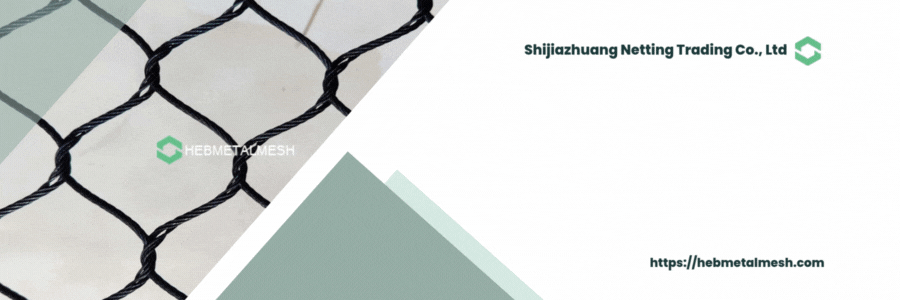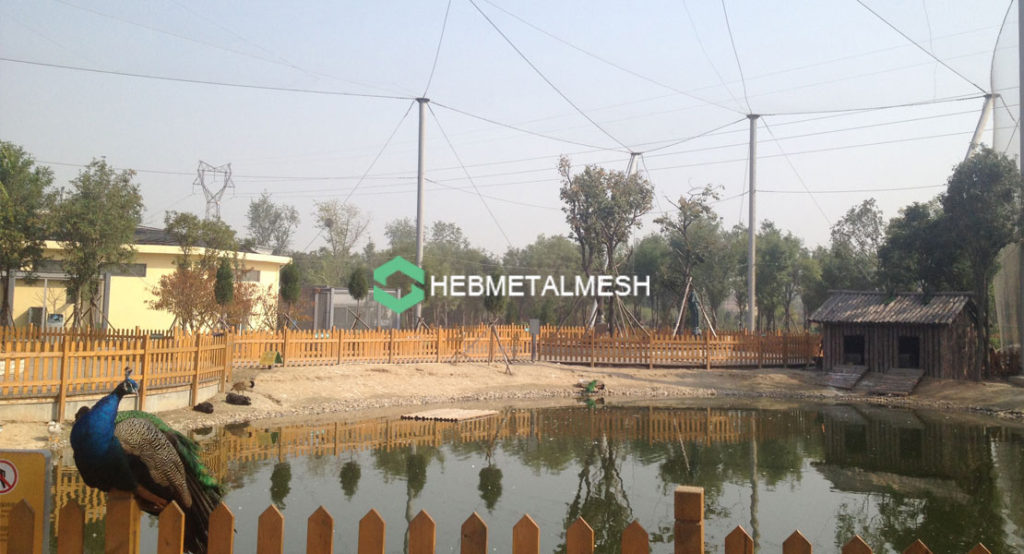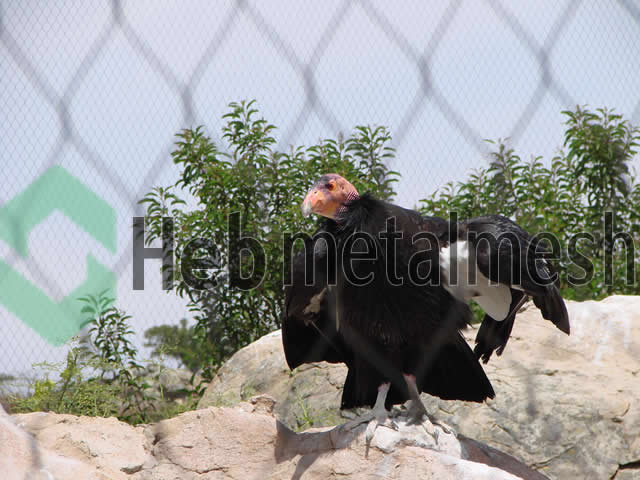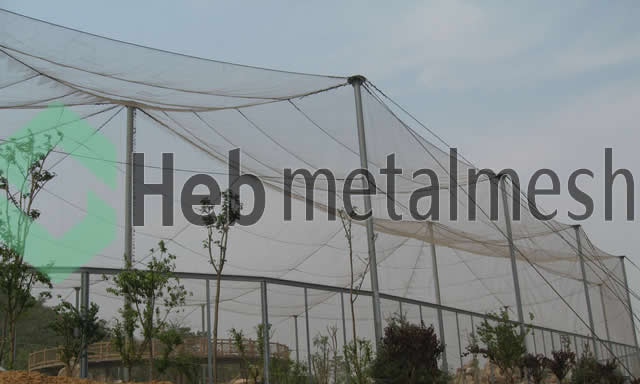Introduction: The Importance of Choosing the Right Aviary Net
Aviary nets play a vital role in creating secure habitats for birds, whether in private aviaries, public zoos, or agricultural projects. These nets serve as protective barriers that prevent birds from escaping while simultaneously safeguarding them from potential predators. The importance of utilizing the right aviary net cannot be overstated; selecting a high-quality product is critical to the welfare of the birds and the integrity of the aviary environment.
When considering an aviary net, one must evaluate various materials to ensure longevity and durability. Stainless steel 304 is often recommended due to its excellent resistance to corrosion and weathering. This choice not only ensures that the net maintains its structural integrity over time but also guarantees that it remains visually appealing. Additionally, the choice of aesthetic finishes, such as nature-inspired or black oxide options, can enhance the overall visual appeal of the aviary while blending seamlessly with the natural surroundings.
In addition to material quality, it is essential to consider the net’s design characteristics. For example, the mesh size should be appropriate for the types of birds being housed, preventing escape while allowing for ample ventilation and sunlight. Furthermore, the installation of the aviary net requires careful planning to ensure that it will function effectively in various weather conditions, maintaining a safe haven that meets the needs of its avian inhabitants.
Ultimately, the careful selection and installation of an aviary net represent a commitment to the health and safety of birds within human-controlled environments. By prioritizing quality and aesthetic coherence, aviaries can not only protect their residents but also provide an enjoyable experience for visitors. This foundational understanding sets the stage for further exploration of the multifaceted benefits and considerations associated with aviary nets.
What is an Aviary Net? Understanding Its Purpose
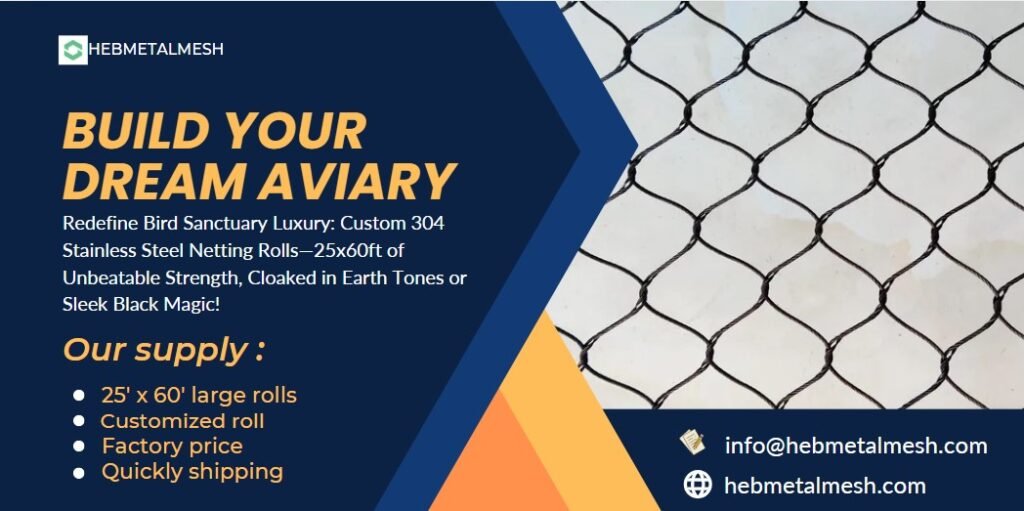
An aviary net is a specialized protective covering designed to safeguard birds within an aviary, ensuring their safety while allowing them to experience the freedom of flight within their designated space. These nets are typically made from durable materials that can withstand various weather conditions, providing both safety and longevity. The primary function of an aviary net is to prevent birds from escaping their habitat and to protect them from potential predators, including cats, hawks, and other animals that pose a threat.
The design of an aviary net incorporates various factors, including mesh size and material strength. The mesh is often fine enough to prevent smaller birds from getting through while ensuring adequate ventilation and sunlight. Different types of nets are available on the market, catering to the diverse needs of bird species and aviary configurations. Common materials used in aviary nets include nylon and polyethylene, with each offering unique benefits in terms of resilience and UV protection.
Additionally, aviary nets can be tailored to fit specific aviary dimensions, enabling a broad range of installation options. This adaptability in design allows bird owners to create suitable environments that mimic natural conditions, promoting the wellbeing of their avian companions. Furthermore, many aviary nets come with added features such as protective coatings, which help to extend the life of the material and resist wear from environmental factors.
Ultimately, the use of aviary nets plays a crucial role in maintaining a safe and enjoyable habitat for birds. By adequately understanding and utilizing aviary nets, bird enthusiasts can significantly enhance their aviary experience, promoting the health and happiness of their feathered friends.
Why Choose Stainless Steel 304 for Your Aviary Net?
When it comes to selecting the right material for constructing aviary nets, stainless steel 304 stands out as an excellent choice. This specific grade of stainless steel offers numerous benefits, making it ideal for both indoor and outdoor aviary systems. One of the key attributes of stainless steel 304 is its remarkable durability, which ensures that it can withstand the rigors of various environmental conditions without succumbing to wear and tear. Aviary nets made from this high-quality material are likely to last significantly longer than those constructed from lower-grade alternatives.
Another critical advantage of stainless steel 304 is its impressive corrosion resistance. Unlike other materials that may rust or deteriorate over time due to exposure to moisture or harsh elements, stainless steel 304 maintains its integrity. This characteristic is especially important for aviaries located in humid climates or areas with frequent rainfall, where other metal nets might quickly become compromised. The resistance to corrosion not only extends the lifespan of the aviary net but also minimizes the need for frequent replacements or repairs, providing a cost-effective solution in the long run.
Furthermore, stainless steel 304 possesses exceptional strength, making it a reliable choice for securing your aviary environment. This enhanced strength reduces the risk of breakage, ensuring that birds remain safely enclosed. The structural stability provided by stainless steel nets is crucial for protecting avian species from potential threats, whether they are predatory animals or adverse weather. Overall, the choice of stainless steel 304 for aviary nets combines durability, corrosion resistance, and strength, offering a robust framework that elevates the overall experience within your aviary space.
Aesthetic Appeal: Nature and Black Oxide Finishes
The visual aspects of aviary nets play a crucial role in enhancing the overall aesthetic of bird habitats. Aviary nets are not merely functional; they also contribute significantly to the exhibit’s appeal. Among the various finishes available, nature-inspired colors and black oxide finishes stand out as popular choices that harmonize sight and utility.
Nature-inspired colors for aviary nets are designed to blend seamlessly into outdoor environments. Shades of green, brown, and tan can mimic the surrounding foliage and earth, allowing the aviary structures to maintain a natural appearance without overwhelming the visual landscape. This approach is particularly beneficial for bird exhibits in botanical gardens or wildlife reserves, where the integration with natural surroundings creates a serene ambiance. The intrinsic beauty of these colors enhances the visual comfort for both birds and visitors, promoting a sense of peace and allowing for an immersive experience.
On the other hand, black oxide finishes provide a modern and sleek alternative. The deep, elegant look of black oxide nets adds a contemporary edge to aviaries, creating a striking contrast against vibrant birds and lush greenery. This finish not only elevates the aesthetic appeal but also offers a level of durability that withstands the harsh outdoor elements. Black oxide finishes reflect a sophisticated charm, which can be particularly appealing in urban or landscaped aviary settings. The integration of these finishes allows aviary architects to design exhibits that are not only functional but visually stunning as well.
Ultimately, choosing the right aesthetic finishes for aviary nets can significantly impact not only the overall appearance of the aviary but also the experience of its visitors. A balanced blend of nature-inspired colors and modern black oxide finishes can create an inviting atmosphere that celebrates the beauty of both birds and their habitats.
Exploring Size Options: The Magic of Large Roll Sizes

The selection of the appropriate size for an aviary net is a critical aspect of constructing a suitable environment for birds. Large roll sizes, particularly those measuring 30′ x 60′, offer several practical benefits that can significantly enhance the installation process and customization options. By considering these larger dimensions, aviary enthusiasts can streamline their projects in various ways.
One of the primary advantages of opting for large roll sizes is the simplification of installation. With a 30′ x 60′ roll, users can cover larger areas with fewer seams, reducing the potential for gaps that could allow for escapes or introduce predators. Fewer seams not only improve the overall aesthetic of the aviary but also contribute to structural integrity, ensuring that the net withstands environmental elements such as wind and rain without compromising safety.
Additionally, large roll sizes offer greater flexibility in customization. Each aviary presents unique dimensions due to various installations, whether they are freestanding structures or attached to existing spaces. A 30′ x 60′ aviary net allows for seamless adjustments, as the expansive material can be cut or tailored to fit even the most unconventional layouts. This adaptability proves invaluable for users who may wish to expand or modify their aviary in the future, as the netting can easily accommodate such changes.
Moreover, the logistical benefits of handling larger rolls can save time and cost. Fewer purchases mean less frequent trips to supply stores and potentially lower shipping fees. Therefore, investing in large roll sizes for aviary nets is a pragmatic choice that not only meets the immediate needs of avian care but also supports long-term planning and development.
Customizable Rolls: Tailoring the Perfect Aviary Net for Your Needs
When it comes to enhancing your aviary experience, the significance of a well-fitted aviary net cannot be overstated. Customizable rolls provide a unique solution, allowing individuals to select the dimensions and specifications that best suit their particular needs. This flexibility is particularly advantageous for both home aviaries and commercial bird exhibits, where unique spatial requirements must be considered.
Choosing a customized aviary net enables you to achieve the appropriate coverage and protection for your birds. Whether you are housing exotic species or more common varieties, having a net that fits seamlessly within your designated space is crucial. This ensures not only the safety of your birds but also the integrity of the aviary’s design, maintaining aesthetic appeal while providing functionality.
Purchasing customizable rolls means you can decide on key features such as mesh size, material, and color. For example, if you are caring for smaller bird species, a finer mesh might be necessary to prevent escapes, while larger birds might require a sturdier fabric to withstand inevitable wear and tear. Furthermore, specific environmental considerations, like resistance to the elements, can dictate the type of material you choose. Hence, tailored solutions enhance both the longevity of the aviary net and the overall well-being of the birds housed within.
This level of customization ensures that you have the right amount of aviary netting to avoid waste, ultimately optimizing your investment. Additionally, many suppliers offer professional consultation to assist in selecting the best options for your unique project, making sure you have all the necessary specifications covered. By investing in a customized aviary net, you are taking proactive steps toward creating a safe and thriving environment for your birds.
Applications of Aviary Nets: From Home Projects to Zoos
Aviary nets serve a multitude of applications, catering to diverse needs, ranging from personal home initiatives to large-scale zoo exhibits. Their versatility is a significant advantage, as they can be customized for various sizes and purposes, ensuring the safety and comfort of birds in different environments.
In residential settings, an aviary net can be employed to create safe outdoor spaces for pet birds. Homeowners often construct aviaries that allow their birds to enjoy fresh air and natural sunlight while being protected from predators. By utilizing aviary nets, enthusiasts can rest assured that their birds are safeguarded from potential dangers, such as neighborhood cats or hawks. Additionally, these nets can also protect garden spaces from birds consuming fruits and vegetables, thereby serving a dual purpose.
On farms, aviary nets are used to secure poultry and other types of birds. The agricultural industry relies heavily on such nets to prevent birds from flying away and to keep wildlife at bay. Implementing aviary netting not only enhances the safety of farmed birds but also assists in maintaining a balanced ecosystem by minimizing unwanted animal access to specific areas.
Moreover, professional zoos and wildlife sanctuaries utilize aviary nets to create naturalistic enclosures that promote well-being among aviary species. These nets facilitate a non-intrusive observation of birds while allowing for adequate flight space and social interaction. Designed with the intent to replicate their natural habitat, aviary nets contribute to the welfare and conservation of various avian species.
The adaptability of aviary nets makes them essential tools in many scenarios. From small-scale home projects to extensive zoological applications, the functionality and practicality offered by aviary nets render them an invaluable asset in protecting and nurturing avian life.
Installation Tips: Ensuring Your Aviary Net is Secure and Effective
Installing an aviary net is a crucial step in creating a safe and effective environment for your birds. Proper installation not only ensures the durability of the net but also protects your avian friends from potential threats such as predators and harsh weather conditions. To achieve a secure installation, it is essential to follow best practices that will maintain the net’s integrity over time.
First and foremost, selecting the right aviary net material is imperative. Consider using a high-quality polyethylene net that offers UV resistance and robustness against wear and tear. When preparing for installation, ensure that the area is properly cleaned and free of sharp objects that could potentially damage the net. Choosing the appropriate size for your aviary is equally important; the net must be large enough to cover the entire space without tension, which could lead to tearing.
Next, secure the net using suitable fasteners such as stainless steel clips or cable ties. Metal fasteners are recommended as they are more durable and less prone to rust compared to plastic alternatives. Install the net tautly but not excessively tight, allowing for natural expansion and contraction due to temperature fluctuations. It is wise to install support poles if your aviary is particularly large, ensuring that the net’s weight is evenly distributed.
Regular maintenance is another key aspect of preserving the functionality of your aviary net. Inspect the net periodically for any signs of wear, such as fraying or holes, and address any issues promptly. Keeping the surrounding area cleared of debris will also help maintain the integrity of the net over time. By following these installation tips, you can ensure that your aviary net remains not only secure but also effective in protecting your birds, ultimately enhancing their living conditions.
FAQs About Stainless Steel Aviary Netting: Durability, Safety, and Custom Solutions
Stainless steel aviary netting is a durable, rust-resistant mesh designed to create secure outdoor or indoor habitats for birds. It’s favored for its strength, longevity, and resistance to weather, making it ideal for searches like “heavy-duty stainless steel aviary netting for outdoor bird enclosures” or “weatherproof bird cage netting.” Unlike cheaper materials, it withstands UV rays, rain, and temperature fluctuations, ensuring long-term protection against predators and escapes.
Stainless steel outperforms galvanized and nylon nets in harsh environments due to its non-corrosive properties. For those researching “galvanized vs stainless steel aviary netting durability” or “best rust-resistant netting for coastal aviaries,” stainless steel is a top choice. It won’t rust, flake, or degrade over time like galvanized steel, and unlike nylon, it resists chewing from larger birds and UV damage, offering a safer, longer-lasting solution.
Yes! Stainless steel nets are non-toxic and feature smooth, burr-free edges to prevent injuries. Searches like “safe stainless steel mesh for parrot aviaries” or “avian-friendly netting for finch enclosures” emphasize its safety. The material doesn’t release harmful chemicals, making it suitable for birds prone to chewing or sensitive species. Proper installation ensures no sharp points, keeping claws and feathers protected.
Absolutely. Many suppliers offer custom sizing and shapes for DIY projects or commercial setups. Keywords like “custom-cut stainless steel aviary mesh for odd-shaped cages” or “modular stainless steel panels for large aviaries” cater to users needing tailored solutions. Customization ensures seamless coverage for domed enclosures, balconies, or walk-in aviaries while maintaining structural integrity and aesthetics.
Stainless steel nets require minimal maintenance—occasional rinsing with water to remove debris and inspections for tension. With a lifespan of 15–20+ years, they’re a cost-effective choice for terms like “low-maintenance stainless steel bird netting for zoos” or “long-lasting aviary mesh for breeders.” Avoid abrasive cleaners to preserve the finish, and check anchor points periodically to ensure stability, especially in high-wind areas.
Conclusion
Selecting the appropriate aviary net can significantly enhance the functionality and aesthetic appeal of any aviary. The transformative impact of using high-quality materials, such as stainless steel 304, cannot be overstated. This type of netting offers durability and resistance to wear, ensuring that it withstands environmental challenges while providing ample safety for birds. Its strength not only protects avian inhabitants from potential threats but also guarantees a long-lasting solution for aviary enthusiasts.
Moreover, the versatility of modern aviary nets allows for customizability, catering to the unique requirements of different aviaries. Whether an aviary is designed for smaller birds or larger species, the option to tailor dimensions, mesh size, and other features ensures that every project meets its specific demands. Such personalization contributes to creating an environment where birds can thrive while minimizing risks associated with escape or injury.
Aesthetic value is another crucial factor in the choice of aviary nets. The right aviary net not only serves functional purposes but also enhances the overall appearance of the enclosure. With various colors and designs available, aviary owners have the opportunity to complement their garden or landscaping, making the aviary an attractive feature of their property. By carefully selecting materials that blend harmoniously with the environment, bird lovers can create a visually appealing space that celebrates nature while keeping their feathered friends safe.
Ultimately, making informed decisions regarding the selection of an aviary net can lead to significant improvements in the overall aviary experience. By prioritizing materials like stainless steel 304, exploring customizable options, and considering aesthetic factors, readers can ensure that they are well-equipped to elevate the quality of their aviaries, creating a sanctuary that offers both beauty and safety.
